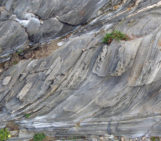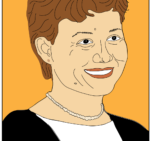
This study provides a simple numerical model of fault rupture that describes the development of fault systems from the initial nucleation of numerous small faults to the localisation of deformation into few major faults. The model presented is based on two main considerations: first, earthquakes cause stress changes that can either advance or delay failure on neighbouring faults. Second, for failure to happen faults must heal and recover most of their shear strength on timescales shorter than the earthquake cycle. The model of Cowie supports that this “healing-reloading feedback mechanism” bears several implications for faults systems.

Fig. 1. Block diagram illustrating the evolution of a fault pattern for which the healing–reloading stress feedback mechanism plays a dominant role, based on results of the numerical modelling. (a) Stage 1: initial nucleation of many isolated faults. (b) Stage 2: enhanced growth of those faults which are optimally located with respect to neighbouring structures (W, X, Y, Z). Suppressed growth of faults which are not optimally located. (c) Stage 3: localisation of deformation onto a few through-going faults (Z, Y) and activity ceasing on faults in intervening regions (X, W). From Cowie, 1998.
The main claim of the contribution is that the ‘Coloumb Failure Function’ of Caskey and Wesnousky (1997) determines the localisation and self-organisation of brittle deformation in fault systems. In other words, the orientation of the fault array with respect to regions of increased (or decreased) stress determines the faults’ likelihood of failure and its location. This implies that faults in favourable relative positions trigger and are triggered by each other, resulting in a more rapid failure, whereas neighbouring faults located in stress shadows from each other delay their rupture, resulting in infrequent activity. As a result, it is not only the location of a fault with respect to the regional stress field that determines its activity, but also its location with respect to neighbouring faults (Fig. 1).
As a consequence of both positive and negative feedback, some faults grow rapidly, exhibiting high displacement rates even during the early stages of the deformation and regardless of their length, whereas other faults experience low displacement rates and may eventually become inactive.
An important outcome of the model is an increased complexity in distinguishing quiescent and active faults for seismic hazard purposes, given that the healing-reloading feedback is particularly relevant in the development of large faults. Earthquake clustering, observed in paleoseismology studies (e.g., Marco et al., 2006) and other geological records (e.g., Nicol et al., 2006; Mouslopoulou et al., 2016), can be attributed to a variety of deep tectonic processes, but a clear understanding of its causes is still lacking.
Similarly, short term events of cascading faulting, such as the 2016 Kaikoura earthquake (e.g., Zhang et al., 2017), or the complex fault interaction observed during the 2019 Ridgecrest earthquake (e.g., Toda & Stein, 2020) demonstrate the value and relevance of Cowie’s ground-breaking observations.
Written by Silvia Crosetto, David Fernández-Blanco, Gianluca Frasca and the TS Must Read team
References
Caskey, S. J., & Wesnousky, S. G. (1997). Static stress changes and earthquake triggering during the 1954 Fairview Peak and Dixie Valley earthquakes, central Nevada. Bulletin of the Seismological Society of America, 87(3), 521-527. doi: https://doi.org/10.1785/BSSA0870030521
Cowie, P. A. (1998). A healing–reloading feedback control on the growth rate of seismogenic faults. Journal of Structural Geology, 20(8), 1075-1087. doi: https://doi.org/10.1016/S0191-8141(98)00034-0
Marco, S., Stein, M., Agnon, A., & Ron, H. (1996). Long‐term earthquake clustering: A 50,000‐year paleoseismic record in the Dead Sea Graben. Journal of Geophysical Research: Solid Earth, 101(B3), 6179-6191. doi: https://doi.org/10.1029/95JB01587




Xin Xianwu
Studying earthquakes from the perspective of fractures is the right direction. Deep rock formations heal after an earthquake, which is an important reason why periodic earthquakes occur at the same location.
For the causes of earthquakes, please refer to: https://doi.org/10.5446/48979